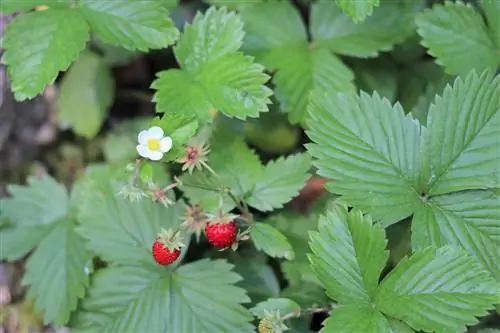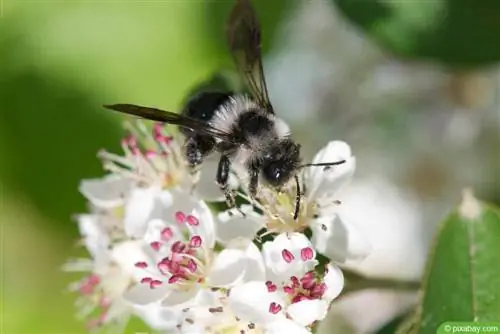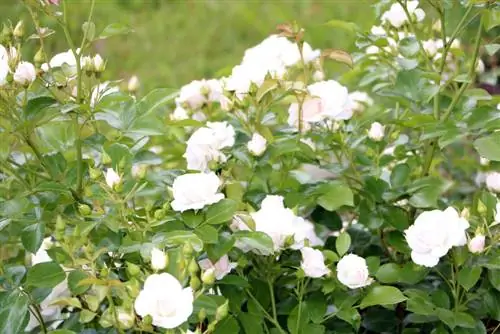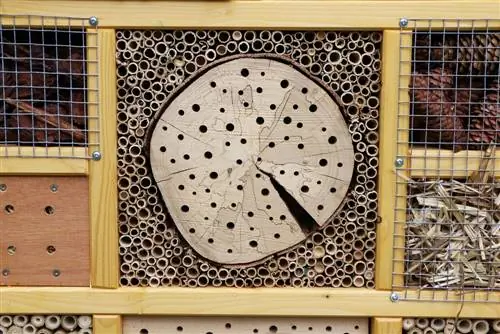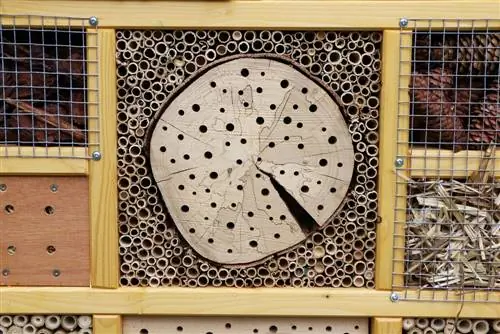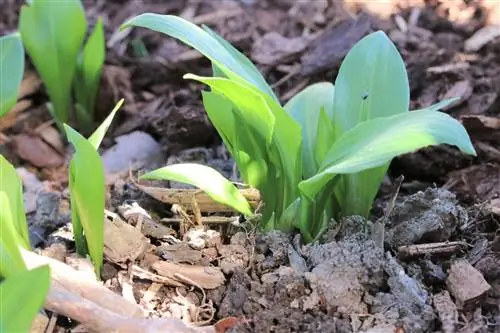- Author admin [email protected].
- Public 2023-12-17 03:39.
- Last modified 2025-06-01 06:48.
Wild strawberry, often called monthly strawberry, is a small, decorative plant from the rose family. Used as an effective ground cover, the wild strawberry is not only a feast for the eyes, but also bears small fruits with a delicate, sweet taste. Fragaria vesca is an easy-care, hardy plant and spreads quickly with the right care.
Wild strawberry - a popular garden plant
The monthly strawberry, whose fruits have delighted people with their sweetness for thousands of years, can be found everywhere in Europe. The plant usually grows in large colonies at the edge of forests, be they deciduous or coniferous. Varieties of wild strawberries are common as a garden plant; they bloom longer and more luxuriantly than their “wild” relatives and bear slightly larger fruits. The plant grows between 5 cm and 30 cm high, the five-fold small (1-2 cm) flowers are white with yellow stamens, the collected fruit changes color from green-white to carmine-red as it ripens.
Usage
Both the flowers and the red fruits have a decorative effect - the Fragaria vesca is a garden ornament. The plant is a beautiful ground cover, is also suitable for stone beds and also looks attractive as an hanging basket plant. Fruits are a delicious summer snack and also taste delicious in jam. The wild strawberry starts to bloom in April, and from the beginning of June until the end of August (depending on the weather) it is harvest time.
Location
Since Fragaria vesca prefers to grow on the edge of the forest in nature, it is obvious that this plant feels comfortable in a partially shaded location. In order for the fruits to ripen, several hours of direct sunlight per day are necessary, but in a full sunny location on the south side of the house, the monthly strawberries can burn. In the shade, the plant withers and hardly bears any fruit
Tip:
Even if there are only a few trees on the property, a small false cypress or thuja planted in the strawberry bed can provide enough shade for the wild strawberries thanks to its very dense growth.
Set
In order to properly plant a young plant, a planting hole with a diameter of around 15 - 20 cm (depending on the size of the plant) and a depth of 10 - 15 cm is dug. The monthly strawberry should be covered with soil again up to the roots and watered thoroughly immediately. Wild strawberries should be planted at a distance of approx. 1.5 - 2 m from each other as the plants spread quickly. The wild strawberry can always be planted in the frost-free period; the optimal time is April - early May.
Tip:
When purchasing, ask whether the variety actively forms runners, if this is not the case, the distance can be reduced.
Substrate
The monthly strawberry loves loose humus-rich soils with a low to normal pH value (values between 5 and 7). Slightly sandy soils are also good for the plant. In order to loosen the soil and at the same time save yourself the hassle of digging, it is worth applying a 3-5 cm thick layer of mulch. The mulch also makes the soil slightly acidic and prevents it from drying out. Substrates containing peat also have the same effect.
Pouring
An important prerequisite for the successful care of Fragaria vesca is regular watering. Not only the young plants, but also fully grown wild strawberries must be kept moist. Drying out quickly leads to yellowing of the leaves and even death of the plant. It is recommended to water with soft rainwater or with water from the well; the tap water should first be filled into a watering can for a few hours.
Tip:
Add some peat to the irrigation water to lower the pH value.
Fertilize
As already mentioned above, the monthly strawberry is a robust plant that does not require extensive care. The Fragaria vesca can be supplied with the special berry fertilizer once or twice per season; it is no problem to reduce the specified dosage a little. Alternatively, the plant can be supplied with organic fertilizer alone; it is also sufficient to fertilize it with compost once or twice a season (in spring and autumn). It is recommended to use between three and five liters of compost per square meter of bed area.
Wintering
The small plant is hardy and can also tolerate severe frost. If the wild strawberry is grown in a bucket or flower pot as an hanging plant, it is advisable to wrap the pots warmly for the winter with fleece or jute fabric. If the roots of the monthly strawberry freeze, the plant may die. The above-ground parts of the plant do not need to be removed for the winter, but yellowed or diseased leaves should be cut off. Alternatively, the wild strawberry can overwinter as a pot culture in an unheated winter garden. As soon as the nights are frost-free, the plant should leave its winter quarters. Warm overwintering weakens the plant and is not recommended.
Propagate
The Fragaria vesca reproduces through pollination and spreads further through the so-called endochory, in which the fruits are eaten by animals and people and the seeds are excreted again. On the other hand, the monthly strawberry reproduces vegetatively. The latter method in particular is predominantly used by gardeners to propagate the plant. Proceed as follows:
- a young plant that has already taken root is dug out of the ground with great care
- The rhizome that connects the young plant to the mother plant must be cut off with secateurs
- Now the new wild strawberry can be planted in the desired location
Pulking monthly strawberries from seeds is also usually easy. In early spring, the seeds are pressed into a box or pot with growing soil and always kept moist. The plants germinate after about 4 to 6 weeks and can be planted in the garden two to three weeks later.
Tip:
When purchasing, ask whether the specific variety is one of the light germinators. If this is the case, the seeds must not be pressed into the soil, but should remain on the surface.
Diseases and treatment options
Although quite resilient, the plants can suffer from root rot if not cared for properly. Rotting roots indicate that the plants are placed in the wrong substrate. Heavy soils and a lack of drainage are particularly damaging to wild strawberries. The only way to remedy this is to loosen the soil or transplant. Powdery mildew is another disease that threatens monthly strawberries. Conventional fungicides help combat this fungal disease.
Frequently asked questions
Which plants can the wild strawberry be combined with?
For example, legumes and onions thrive in the same bed as Fragaria vesca. Boxwood or cypress trees provide sun protection.
Is the garden strawberry a cultivated form of the wild strawberry?
No, the “big strawberry” is related to the monthly strawberry and belongs to the same family, but was created about 200 years ago from crossing Chilean strawberries and scarlet strawberries on the American continent.
What you should know about wild strawberries in brief
Plants and Location
- Wild strawberries can be planted anywhere that has humus-rich, moist soil in a sunny to partially shaded area.
- The easiest way to plant wild strawberries is to plant individual strong plants.
- Some patience is required for sowing seeds. Pre-cultivation in a small greenhouse or under foil should be considered.
- During the planting period, the wild strawberry, like its big sister, should not be fertilized in order to encourage the plant to grow.
- After the growing phase, the wild strawberry should not only be watered regularly, but also fertilized occasionally.
- Natural fertilizer in the form of manure and humus from compost or small amounts of strawberry fertilizer is ideal.
Propagation
- The wild strawberry does not help with propagation, as the underground roots spread just as much as the above-ground offshoots.
- However, excessive spread can be controlled by simply removing the runners.
- If propagation is not fast enough for you, the offshoots can help you root.
- For this purpose, only the above-ground runners are pressed slightly into the earth.
Winter Care
- As a hardy plant, the wild strawberry can overwinter outdoors without any special care or preparation measures.
- In pot culture, however, the wild strawberry should overwinter in a cool, frost-free place to avoid the roots freezing.
- From March, however, the pot-grown wild strawberry can also return outdoors to begin its natural growth cycle again.
Harvesting & Processing
- The small white flowers in spring develop into 1 to 2 cm large wild strawberries in early to mid-summer.
- Even unsweetened, they offer a delicious summer treat that can be used on their own as well as in the kitchen.
- Desserts, salads or summer drinks (also with sparkling wine) are ideal, as are processing into jams.
- Note: Making wild strawberry jam is easy, but requires a large amount of fruit. The flavor suffers due to the added sugar.

